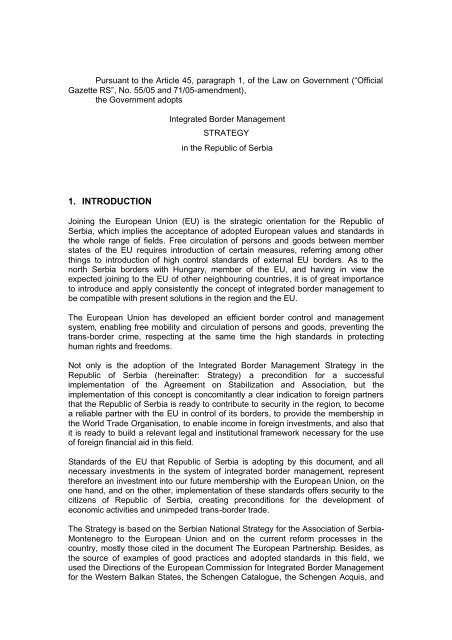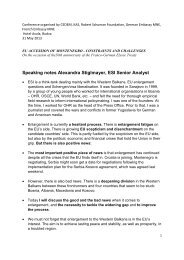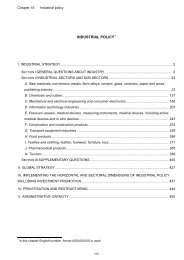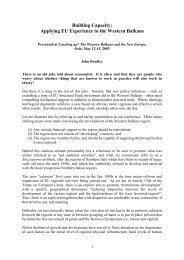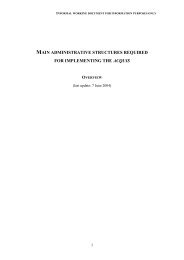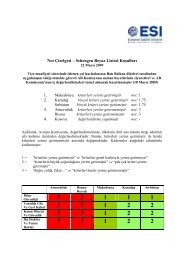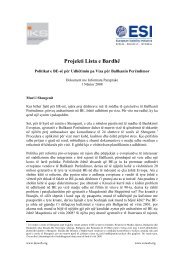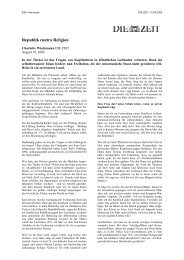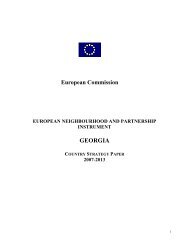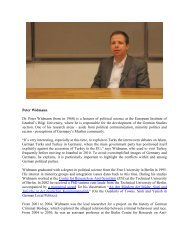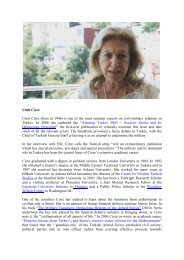Strategy for integrated border management
Strategy for integrated border management
Strategy for integrated border management
You also want an ePaper? Increase the reach of your titles
YUMPU automatically turns print PDFs into web optimized ePapers that Google loves.
Pursuant to the Article 45, paragraph 1, of the Law on Government (“Official<br />
Gazette RS”, No. 55/05 and 71/05-amendment),<br />
the Government adopts<br />
1. INTRODUCTION<br />
Integrated Border Management<br />
STRATEGY<br />
in the Republic of Serbia<br />
Joining the European Union (EU) is the strategic orientation <strong>for</strong> the Republic of<br />
Serbia, which implies the acceptance of adopted European values and standards in<br />
the whole range of fields. Free circulation of persons and goods between member<br />
states of the EU requires introduction of certain measures, referring among other<br />
things to introduction of high control standards of external EU <strong>border</strong>s. As to the<br />
north Serbia <strong>border</strong>s with Hungary, member of the EU, and having in view the<br />
expected joining to the EU of other neighbouring countries, it is of great importance<br />
to introduce and apply consistently the concept of <strong>integrated</strong> <strong>border</strong> <strong>management</strong> to<br />
be compatible with present solutions in the region and the EU.<br />
The European Union has developed an efficient <strong>border</strong> control and <strong>management</strong><br />
system, enabling free mobility and circulation of persons and goods, preventing the<br />
trans-<strong>border</strong> crime, respecting at the same time the high standards in protecting<br />
human rights and freedoms.<br />
Not only is the adoption of the Integrated Border Management <strong>Strategy</strong> in the<br />
Republic of Serbia (hereinafter: <strong>Strategy</strong>) a precondition <strong>for</strong> a successful<br />
implementation of the Agreement on Stabilization and Association, but the<br />
implementation of this concept is concomitantly a clear indication to <strong>for</strong>eign partners<br />
that the Republic of Serbia is ready to contribute to security in the region, to become<br />
a reliable partner with the EU in control of its <strong>border</strong>s, to provide the membership in<br />
the World Trade Organisation, to enable income in <strong>for</strong>eign investments, and also that<br />
it is ready to build a relevant legal and institutional framework necessary <strong>for</strong> the use<br />
of <strong>for</strong>eign financial aid in this field.<br />
Standards of the EU that Republic of Serbia is adopting by this document, and all<br />
necessary investments in the system of <strong>integrated</strong> <strong>border</strong> <strong>management</strong>, represent<br />
there<strong>for</strong>e an investment into our future membership with the European Union, on the<br />
one hand, and on the other, implementation of these standards offers security to the<br />
citizens of Republic of Serbia, creating preconditions <strong>for</strong> the development of<br />
economic activities and unimpeded trans-<strong>border</strong> trade.<br />
The <strong>Strategy</strong> is based on the Serbian National <strong>Strategy</strong> <strong>for</strong> the Association of Serbia-<br />
Montenegro to the European Union and on the current re<strong>for</strong>m processes in the<br />
country, mostly those cited in the document The European Partnership. Besides, as<br />
the source of examples of good practices and adopted standards in this field, we<br />
used the Directions of the European Commission <strong>for</strong> Integrated Border Management<br />
<strong>for</strong> the Western Balkan States, the Schengen Catalogue, the Schengen Acquis, and


